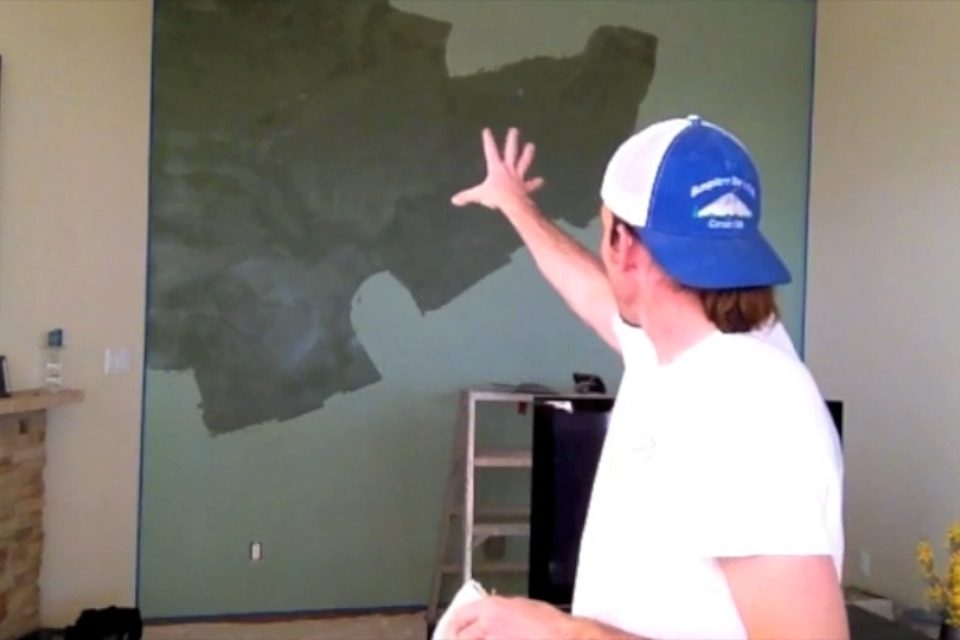There are two different lenses through which a wall can be viewed: the eyes of a drywall finisher, and observations by everyone else.
It’s always fascinating to me how little people know about the various mediums inherent in the drywall industry. We’re surrounded by walls our entire lives, yet we pay little or no attention to how they were created. Yet often, we tell each other that we hate the texture in our homes and wish there were a way to improve them.
To begin with, we need to address the mediums. Many people refer to drywall mud as “spackle.” If you’re not in the trade (or even if you are) don’t ever call drywall mud “spackle.” This will only succeed in establishing you as an ignoramus, and you’ll immediately be discredited by the tradesmen in the field. Much like the art world, the drywall industry is comprised of different mediums and those mediums are designed for different purposes. Plaster is both a medium and a trade. Drywall and plaster are two completely different trades of the construction industry, but both will be addressed here because they both pertain to the topic of smooth. For the purpose of this article, all you need to know is that plaster is a specialized wall finish and is at no time used in the drywall industry. In turn, drywall mud, is never, or rarely, used in the plaster industry. These elements of wall finish are so completely different that they have their own specific trade unions. So next time you’re in someone’s home, and you say, “I just love the plaster on these walls!” be careful you’re not referring to their textured drywall.
Ok, to follow up:
– Don’t ever use the word, “spackle;” you’ll sound ignorant. Always call it “mud.”
Plaster and joint compound are two different mediums and should be addressed separately — always.
Smooth finish is not really smooth. Oh wait! We’re not there yet! That’s right, I was going to talk about smooth finish. Thanks for being patient.
Now that we have a minimal understanding of the mediums/trades, I guess we can talk about how those guys and gals make walls smooth… or not.
As defined by the USG Drywall Industry Standards, the levels of drywall finish are broken down into 5 numbers. We’re just talking about drywall here and not plaster. We’re not talking about texture either. We’re just talking about getting the wall ready for texture. Imagine you have a freshly hung piece of Sheetrock. Every seam where the Sheetrock attaches to the wall stud needs to be filled and covered with drywall tape and joint compound. This is the drywall finisher’s job: to make the wall appear flat (even though it actually isn’t) for future texture or smooth finish — and eventually paint. The levels of finish as defined by the industry are basically the finishing steps involved in creating a flat wall. I’m giving each my own definition so you won’t have to read the boring USG version. You’re welcome.
Level 1. – Tape the joint and don’t wipe out the excess mud. If you only ran this finish on your new home, then it would look atrocious and your neighbors would look at you funny. This is a minimal finish, often used in mechanical rooms for fire prevention. A smart general contractor, to save money, might attempt this level before calling a professional.
Level 2. – Tape joint, wipe mud flat, spot screws/nails once. Drywall is fashioned to the stud with drywall nails and screws. On a level-two finish, those screw heads are spotted with mud once to flatten out the dimple they’ve made. The extra mud on the tape, seams, and angles are ran flat and clean. Corner beads are applied to outside corners, and excess mud is cleaned away. Some General Contractors will attempt to achieve this level. If you are this person, be prepared to pay extra when you have to hire a drywaller to fix the failing surface.
Level 3. – All joints and interior angles should have tape embedded in joint compound and should be immediately wiped with a joint knife or trowel, leaving a thin coating of joint compound over all joints and interior angles. Now we’re starting to get it pretty flat. Still, if you textured and painted over this finish you’d see all the drywall blemishes. This finish is what I affectionately refer to as, “contractor grade” because this is about as flat as a non-professional can make it. That’s being generous.
Level 4. – Requires a professional drywall finisher. All drywall butts, bands, and corner beads are taped and floated with at least two coats of joint compound. All fashioner dimples have three coats, and all inside angles are taped and floated once. With a level 4, you had better sand down your edges (even if they’re perfect) and give those pesky butts some extra love because your wall needs to be ready for a very little texture and a crappy paint job. A normal level 4 finish is considered level 5 smooth wall if you’re anywhere in the southwestern United States. A general contractor will expect this level of finish on every job weather their paying for it or not.
Level 5. – Level 5 is the crème de la crème of drywall finishes. It is the very smoothest of all the drywall finishes and should only be attempted by a true professional. Achieving a level 5 smooth finish is the equivalent of mastery in the trade. The term “Smooth Finish” gets tossed around loosely. Most laymen cannot comprehend the level of knowledge and skill it requires to accomplish a true level 5 smooth wall and thus, have diminished the term from what it actually is. Level 5 smooth finish has a built in “lore” component that’s been passed down through generations, and although there are many different ways to achieve a level 5, no one particular way is the right way. For most who learn how, they’ve had a very competent teacher. If you’re lucky enough to have had a master bestow this knowledge upon you, then consider yourself a member of an exclusive club. I know very few adept Masters personally, but if you go on the Facebook group “Drywallers Worldwide” you’ll find some there.
While working in the union in Portland, Oregon, I was trained under some amazing journeymen, and after many years of experience, I consider myself an expert in these aspects of drywall. I have a good eye for quality finish work, but the only place I’ve seen a true level 5 finish was in Portland, Oregon. Bottom line: a level 5 finish, although elusive, if done properly, looks amazing. It is just very time- consuming, requires great skill, and is extremely costly.
Plaster also has varying degrees of smoothness, lore, and skill attached to it, but I won’t pretend to be an expert. I had one experience with plaster and disliked it so much that I invented Fresco Harmony, my own brand in which I color joint compound then seal with an acrylic sealer. I never understood why a wall has to be so smooth. Likewise, I couldn’t understand why it was necessary to use only plaster. Drywall joint compound is an amazing medium, it colors perfectly, and is easy to use. Also, if you’re covering the entire wall then you only need to finish the wall to a level 3. The Fresco Harmony will do the rest. Plaster requires special drywall, it doesn’t color consistently, and is extremely labor intensive. I’ll just say it. Why isn’t there a colored mud system? Oh wait, there is. www.frescoharmony.com
No matter which trade you’ve been acquainted with, there’s a common theme, and that theme is that “smoother is ALWAYS better.” I’ve had limited experience with plaster, but of the experience I’ve had, I remember the extreme difficulty the most. Although plaster is laborious, expensive and time consuming, the results can be amazing. In both the drywall and plaster applications, there’s a huge amount of energy involved to create a smooth finish. Also, in both applications, the predominant idea is a perfectly smooth wall. With Fresco Harmony the focus is more on affordability and efficiency.
I get it. For some reason smooth walls cater to a calmness that is just not felt with a textured wall. Fresco Harmony is challenging how smooth a wall needs to be, but still look classy and cool. When people ask me if Fresco Harmony is smooth, I tell them that it is. Set aside my definition of true level 5; Fresco Harmony may not be perfectly flat, but it is smooth to the touch. It’s also smooth in appearance. More importantly, that smooth element is achieved with less effort, and the material cost is affordable. Everyone wants a nice smooth plaster look, but few are willing to pay the high prices. What’s the alternative? Ugly texture and paint? Gone are the days of laborious sanding and expensive materials to achieve a beautiful finish. Even hand-textured surfaces are more appealing than spray texture and those take a lot of work. If you’re hand texturing anyway, why not throw color into the mud and create a timeless finish your clients will love? The Fresco Harmony model is challenging the way we view finishing drywall. Now it’s possible to exchange the traditional level 4 (sand, texture and paint method) with the Fresco Harmony, no sanding, method and deliver a finish that’s both efficient and beautiful.
After spending my entire life researching walls I’ve learned one thing, smooth is an illusion. You can make a wall appear very flat but it’s never perfectly smooth. Why not exaggerate that element of imperfection? Texture is an extremely gross exaggeration of flatness. Its only purpose is to hide imperfection. Couldn’t Fresco Harmony be a more refined exaggeration of that antiquated idea? You’ll offer something your competition isn’t, your clients will certainly thank you for it, and your reputation will spread. And remember: Never call it “spackle.”
~ By Nick Harmon
Owner/Creator – Fresco Harmony


5 Comments
FYI, I’ve used ‘Plaster Color’ before. Is there any difference between your ‘Fresco Harmony’ and coloring ‘Diamond Finish’? [Diamond Finish is used in ‘other than’ historically correct restorations.]
Fresco harmony is the nations first color line specifically designed for joint compound.check out some of our videos. Fesco harmony on YouTube.
Love the article, Nick. Very good explaination, and insight.
Great article! What are you guys generally charging for a lvl 5 drywall finish? It is definitely time consuming and difficult, but charging a far price is also important for any consumers.
Hello. Sorry I’m just now getting back to you. I would convince a client to do Fresco Harmony before Level 5 finish. A regular drywall company in Albuquerque would give too competitive a price for us to bid against. Clients best value would be to go with Fresco Harmony.